
|
Student's Study Guide for Lesson Four
by Dr Jamie Love |

|
 and
and  licensed under a Creative Commons Attribution-ShareAlike 4.0 International License.
licensed under a Creative Commons Attribution-ShareAlike 4.0 International License.

|
Student's Study Guide for Lesson Four
by Dr Jamie Love |

|
"Normal" cells contain ___ full sets
of chromosomes and are described as _______.
Abbreviated as __ to remind us that it is a "double"
set.
Most of your cells are diploid - they contain two sets of chromosomes.
Each set of human chromosomes contains __ chromosomes so most cells in your body have __ chromosomes.
Mature gametes, the sex cells (sperm and egg) have only one __
set of chromosomes. Cells with only one set of chromosomes are
called _______. ("Haploeides" is Greek for "______".)
Abbreviated as __ to remind us there's only one set of
chromosomes.
______, the number of chromosomes in a cell, is very important
in genetics and in understanding genetics, so keep track of the
chromosome numbers.
When a diploid cell (2n) undergoes mitosis and cytokinesis it
produces ___ diploid cells (each also of __).
|
Mitosis is often called "____ division" because the genetic material is copied.
(What would happen if gametes were diploid (2n)?)
|

|
During meiosis and the cytokinesis that follow, one diploid mother cell (2n) makes ____ ______daughter cells and they are all _______ (1n)!
| Meiosis is often called "_______ division" because the genetic material is reduced (by ____). |

|
______ reproduction combines the genetic information from
two different cells (usually from two different individuals).
Each parent contributes a haploid (n) ______ (sex cell).
These two gametes, a female egg and a male sperm, fuse to produce
a genetically unique single cell called a _____. The zygote
is diploid (2n) it is "half _________" to each parent.
|
Meiosis reduces the genetic material in half and fertilization
creates a ______ individual from the fusion of those two halves
of genetic material.
When that individual undergoes meiosis his (or her) sperm (or egg) will ____ be a recreation of its father's sperm or mother's egg. An individual will produce _____ gametes containing a quarter of dad's genes and a ______ of mom's genes for a total of a half-filled gamete (haploid - n). That unique gamete will fuse with another (haploid) gamete from elsewhere and that fusion will create another unique ______ that will grow into a unique individual. That new individual will be composed of the genetic materials from…. ___ of mom's mom ¼ of mom's ___ ¼ of ___'s mom ___ of dad's dad |
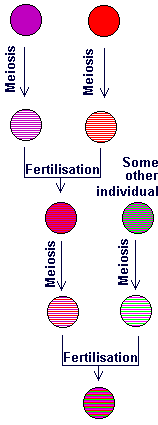
|
Chromosomes must be distributed in a concise manner to make sure that a full set (__) of chromosomes is in the gametes. So, meiosis
|
A diploid cell (2n) is composed of a set (n) from both
_____ and they can be thought of as pairs of ___________.
The chromosomes from your father are called ________ (and can be abbreviated as "P") and those from your mother are called ________ (abbreviated as "M"). [I remember this as " ____ and ____ ".]
These pairs are called __________ pairs (of chromosomes).
|
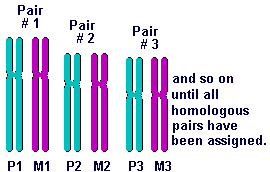
|
|
When the two homologous pairs are aligned (side by side) we call
the pair a ______.
Therefore, a tetrad is composed of two chromosomes - one maternal (__) and one paternal (__). A tetrad will have two centromeres and four __________ (because it is made from two chromosomes). Recall that a dyad was a single (__-shaped) chromosome so a tetrad is composed of ___ dyads. |

|
Meiosis is different from mitosis because there are two _________
and the chromosomes line up differently at the two different metaphase
plates. (As _______ in the first division and as _____ in the
second division.)
We add a I (___) or II (___) to the end of each phase to remind us which division of meiosis we are talking about.
Prophase I looks identical to mitotic prophase but the chromosomes are matched up in homologous _____ and they ____ genetic material between themselves!
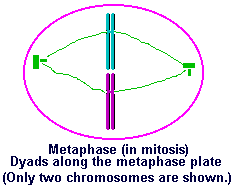
|
In metaphase I (of meiosis I ) _______ are aligned along
the metaphase plate!
Notice that the M and P pairs in the tetrad can be aligned to ______ side. Using a human cell as an example, a mitosis metaphase will show __ dyads (chromosomes) along the metaphase plate but in metaphase I (of meiosis I) the metaphase plate contains 23 _______. |
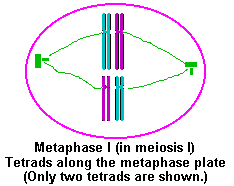
|
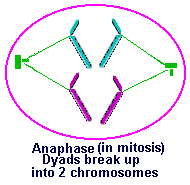
|
In anaphase I (of meiosis I) each tetrad separates into
two _____. The paternal and maternal partners are separated. Anaphase
I is the point at which the _________ division occurs!
Notice that each pair is separated in a ______ direction. |
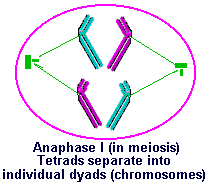
|
After anaphase I comes telophase I and the two newly formed (daughter) nuclei will be _______ (contain n chromosomes). So, after cytokinesis we have two daughter cells that are haploid (and very different from each other - they will be "________ pairs"!).
The second division follows without interphase or S phase so there is no _________ of genetic materials. Both daughter cells enter meiosis II as haploid cells. The centrosomes are __________.
Meiosis II is identical to mitosis except now there will be only
____ as many chromosomes to deal with.
Both of the daughter cells produced from the __________ (which
occurred after meiosis I) will go through ______ II together.
In Prophase II the spindle fibers connect to the chromosomes but this time they grab the chromosomes from both _____ (using both kinetochores) and prometaphase II is like prometaphase of _______ (but with half as many ___________).
|
Metaphase II and anaphase II are _________ to metaphase and anaphase
in of mitosis (except there are ____ as many chromosomes).
At metaphase II the chromosomes line up along the metaphase plate (as a string of _____). At anaphase II the chromosomes are pulled apart into separate chromatids (which are now ___________). Anaphase II is followed by telophase II at which point the chromosomes are bundled into two (haploid) ______, one at each pole. Then cytokinesis occurs and the cell divides its two haploid nuclei between the two new _____. The end result is two cells each with a haploid _______. |
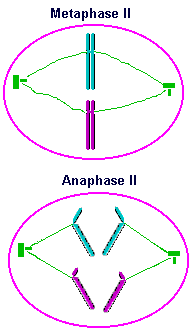
|
